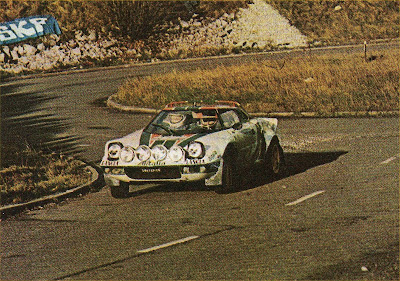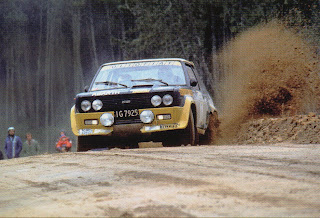 |
| Andruet, Fiat 131 Abarth, 1977 Monte Carlo |
The year began in familiar style. Munari's Stratos won the Monte, as usual, and a Saab won the Swedish, as usual, but then it started to get exciting. Lancia had been told to step aside and let Fiat go for the title, but whilst the other teams had generally let whichever team Turin favoured get on with it for the last three years, for 1977 Ford stuck their head over the parapet and had a crack at the title themselves.

Compared with the sports cars that had dominated the series to date, the cars that the teams would use looked comparatively ordinary. Front engined rear wheels drive cars had more or less been eclipsed by the minis and Porsches of the late sixties, but now they were back. The Ford had the better engine whilst the Fiat had the better suspension. Arguably neither car was yet as good as a Stratos, or a properly backed Porsche 911, but economics now decided that a rally car should look like an ordinary road car, even if what was under the skin bore no resemblance whatsoever to what you'd find at your local dealer.
 This was a trend that would eventually see 500bhp turbo charged specials pretending to look like ordinary hot hatches, but even in 1977 if you wanted to turn your Escort Popular into an RS1800 you'd start by throwing everything away except the shell. At least Ford sold the bits to allow you to do this. Fiat for their part made up for their power disadvantage with increasingly specialist components only available to the works team and a few select privateers.
This was a trend that would eventually see 500bhp turbo charged specials pretending to look like ordinary hot hatches, but even in 1977 if you wanted to turn your Escort Popular into an RS1800 you'd start by throwing everything away except the shell. At least Ford sold the bits to allow you to do this. Fiat for their part made up for their power disadvantage with increasingly specialist components only available to the works team and a few select privateers.When it came to the drivers Fiat took to signing anyone who could win a particular event, sometimes even signing up former winners just to stop them driving Escorts. Ford meanwhile had a fairly stable team that one journalist summed up by the old Jaguar slogan 'space, grace and pace': the larger than life Bjorn Waldegard, the old stager Roger Clark and the young and reckless Ari Vatanen.
The key difference between the teams though was money. Fiat had a steamroller, Ford had a lawnmower. Rally regulations were pretty laid back inn those days so there was unlimited practise and almost unlimited servicing. Fiat arrived on the rallies weeks in advance and tested like mad on the actual stages whilst positioning a fleet of service barges across the countryside. Ford arrived at the eleventh hour and more or less made do. In the end though, this didn't make a lot of difference.
 The duel began in Portugal, a tough rally in those days where the road sections were so tight that some teams even pace noted them. Waldegard looked to be running away with the event, but four punctures slowed him and let Alen's Fiat through. It had been close though.
The duel began in Portugal, a tough rally in those days where the road sections were so tight that some teams even pace noted them. Waldegard looked to be running away with the event, but four punctures slowed him and let Alen's Fiat through. It had been close though. Fiat didn't go to the Safari, but Ford did, and Waldegard survived the floods to win from Datsun and Lancia. The Italian team again failed in Africa as the white and green wedges turned into submarines in what was the wettest Safari on record. Next was Australia where Vatanen was fastest, but managed to crash no less than three times handing victory to Bacchelli's Fiat. The winning margin was less than two minutes, whilst Ari had lost 23 minutes on one stage alone.....
Fiat didn't go to the Safari, but Ford did, and Waldegard survived the floods to win from Datsun and Lancia. The Italian team again failed in Africa as the white and green wedges turned into submarines in what was the wettest Safari on record. Next was Australia where Vatanen was fastest, but managed to crash no less than three times handing victory to Bacchelli's Fiat. The winning margin was less than two minutes, whilst Ari had lost 23 minutes on one stage alone.....Ford got their revenge in Greece where Waldegard triumphed and Fiat transmissions failed.

The 1000 Lakes was next. Ford had decided to add local driver Kyösti Hämäläinen to their line up, an inspired choice as it tuned out. Finland has produced drivers who have conquered the world, on stages and on tracks, but Hämäläinen was the Finn who decided to stay home. A man who would regularly spend 3 or 4 nights a week practising, he knew the Finnish roads so well he could drive the event without pace notes. The result was a terrific duel with Alen which could have gone either way until a rock, possibly placed by an over eager spectator, took out the Fiat's sump after a hyppy. In Canada Vatanen again looked like winning but this time the car, not the driver, let Ford down allowing Timo Salonen made the score three-three.
Things were now very finely balanced. Ford were two points ahead, the difference between a first and a second place, and three rallies remained: two on tarmac and one on gravel. The wildcard was Lancia. Still technically an independent team, the Stratos was still the best car on tarmac and the team was due to enter the Sanremo and Corsica. If the championship went to the RAC Fiat may as well give up. Fiat took no chances. All the stops were pulled out for the next two events whilst Alen was sent to Britain to get some forest practice in.
When it came to rallying on the black stuff Ford were late starters: they didn't even use slicks until the 1975 Manx. Boreham did their best to get the Escort ready, lowering the fuel tank and fitting coil springs at the back but only had time to sort out the dry weather performance. Waldegard went well enough on the first day, but then when the sun set the rain came down. In the end he was beaten by three Fiats and a Lancia, with Jean Claude Andruet talking his first WCR win since the 1973 Monte. It's easy to feel sorry for Ford, but by this time they had been rallying the Escort for ten seasons and so really should have sorted out wet tarmac handling.

After that Waldegard didn't want to go to Corsica so instead Ford sent a young Russell Brookes and signed up local specialist Jean Pierre Nicholas.
Nicholas knew a priest who lived in the hills who could predict (or fix) the weather and with this spiritual help, and final drive that reduced the top speed to 90mph (and the fuel consumption to 6mpg), he set out to take on six Fiats and a brace of Lancias on the twistiest event of the year.
He nearly made it too. On the last loop out of Ajaccio he was third behind Darniche's Fiat and Pinto's Stratos. "Now I think I will attack" he said, but the car had other ideas. The back axle cooked itself and that was that. Fiat won the event and the championship, but it had been a damn close run thing.
Fiat didn't need to go to the RAC, but they went anyway, which at least allowed Ford to get a bit of their own back. Waldegard clinched a classic victory from a hard driving Hannu Mikkola in the uncompetitive Toyota Celica, meaning he had won three of the four most prestigious rounds of the championship.

Personally I was more interested at the time in the battle for the Group 2 up to 1300cc class, where the domination of Skoda and their little 130RS was challenged by the little French Renault 5 Alpines. Fortunately for Skoda the French hatchbacks didn't make it out of the forests and Skoda were to continue to be unbeaten in their class for the rest of the decade and most of the next.
Ford had out up a good fight. In eight outings they had won four rallies and had the fastest car on two other. Only on tarmac had the Fiats been quicker. However in the end they had been beaten by a team with more money that could afford to run six car teams and spend four weeks practicing for each event.
1977 then belonged to Fiat and Waldegard's, but it was also rallying's greatest year and everyone was looking forward to 1978.